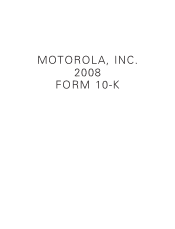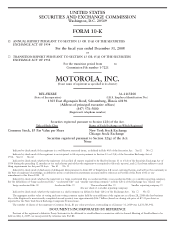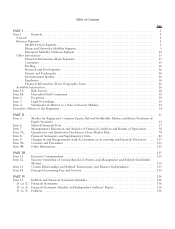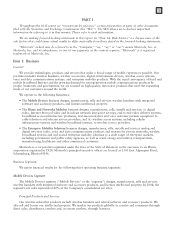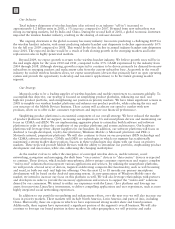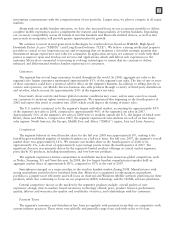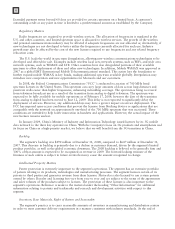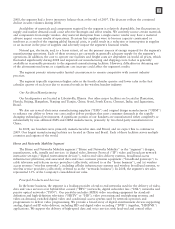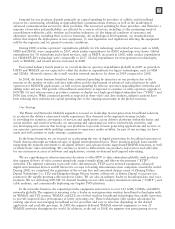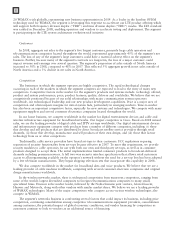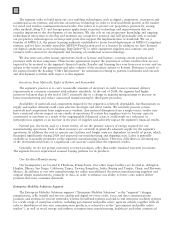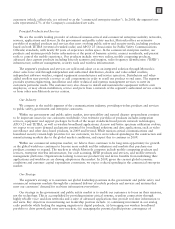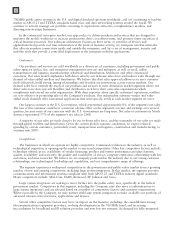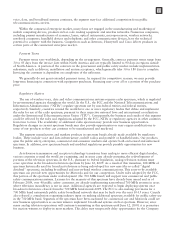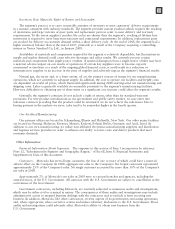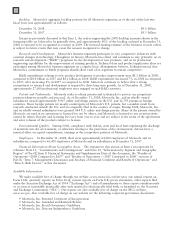Motorola 2008 Annual Report Download - page 14
Download and view the complete annual report
Please find page 14 of the 2008 Motorola annual report below. You can navigate through the pages in the report by either clicking on the pages listed below, or by using the keyword search tool below to find specific information within the annual report.
equipment, along with data and voice modems and gateways for HFC and DSL networks and optical line and
optical node terminals for PON networks.
In the networks business, the segment provides end-to-end cellular networks, including radio base stations,
base station controllers, associated software and services, application platforms and third-party switching for
CDMA, GSM, iDEN
»
and UMTS technologies. The segment also offers a portfolio of WiMAX products and is in
trials with customers to provide our LTE technology to enable next-generation mobile IP broadband access.
WiMAX and LTE will make mobile bandwidth more affordable and accessible for mainstream consumer adoption.
Our products are marketed primarily to cable television operators, telecom operators, wireless service
providers, television programmers and other communications providers worldwide and are sold primarily by our
internal sales force.
Our Industry
The home market is evolving rapidly as cable and telecom network operators expand their video, data and
voice services (commonly known as the “triple play”) to grow their subscriber base. The competition between
cable and telecom service providers continues to increase. Telecom operators are expanding their broadband
networks and beginning to offer advanced video and data services using IPTV and PON technologies. Cable
operators are responding by expanding their investment in HD programming, bundling voice-over-IP services,
expanding their broadband data service through Data Over Cable Service Interface Specifications (“DOCSIS”) 3.0
channel bonding, and maximizing utilization of network bandwidth using switched digital video technology.
Our home business is subject to regulation by the FCC in the United States and other governmental
communication regulators throughout the world. FCC regulations requiring separation of security functionality
from cable set-tops became effective in 2007. This has resulted in increased competition for sales of set-top boxes
to cable operators and has enabled a retail distribution of devices capable of accessing encrypted cable
programming. Our home business offers a cablecard that allows third-party consumer electronic devices to be
deployed on a network using the Motorola conditional access system. Motorola also offers a portfolio of cable
card host set-tops that allows our digital video set-tops to be deployed in service provider networks using third-
party encryption technology.
In the wireless networks market, the majority of installed cellular infrastructure systems are based on CDMA,
GSM, UMTS and iDEN technologies. We supply systems based on each of these technologies and are the sole supplier
of proprietary iDEN networks. Advanced infrastructure systems based on these technologies include GPRS, CDMA-1X
and EDGE. In addition, some segments of the cellular infrastructure industry have installed, or are in the process of
migrating to, 3G networks, which are high-capacity radio access wireless networks providing enhanced data services,
improved Internet access and increased voice capacity. The primary 3G technologies are W-CDMA (based on either
UMTS or Freedom of Mobile Multimedia Access (“FOMA”) technologies) and CDMA 2000 1xEVDO. We supply 3G
systems based on UMTS and CDMA 2000 1xEVDO technologies. An additional 3G technology standard, TD-
SCDMA, has been driven primarily by the Chinese government and local Chinese vendors. China’s Ministry of
Industry and Information Technology awarded 3G licenses in early 2009, which is driving regional network upgrades.
Industry standards bodies are in the process of defining the next generation of wireless broadband systems
after 3G. The Institute of Electrical and Electronics Engineers (“IEEE”) has developed fixed and mobile broadband
standards (802.16d and 802.16e) based on orthogonal frequency division multiplexing (“OFDM”) technology,
which will utilize wider channels and enable triple play services (voice, data, video). These standards are the basis
for WiMAX, a market that experienced strong growth in 2008. Motorola has been awarded a number of WiMAX
contracts and customers in various markets have started to offer commercial WiMAX services utilizing Motorola
infrastructure equipment. We are an early leader in WiMAX technology.
The International Telecommunications Union (“ITU”) has also adopted next-generation cellular wireless
access standards (“4G”) for the cellular infrastructure industry, also based on OFDM technology and known
commonly as LTE. LTE has widespread industry support, not only from current GSM and UMTS operators, but
also from CDMA/EV-DO based carriers.
Licensing bodies of governments around the world are making spectrum available for advanced wireless
technologies, including 4G, in recognition of growing demand for wireless broadband services. Currently,
Motorola estimates that there are over 1,200 licenses available worldwide for advanced wireless technologies with
over 800 licenses outside of North America.
6



